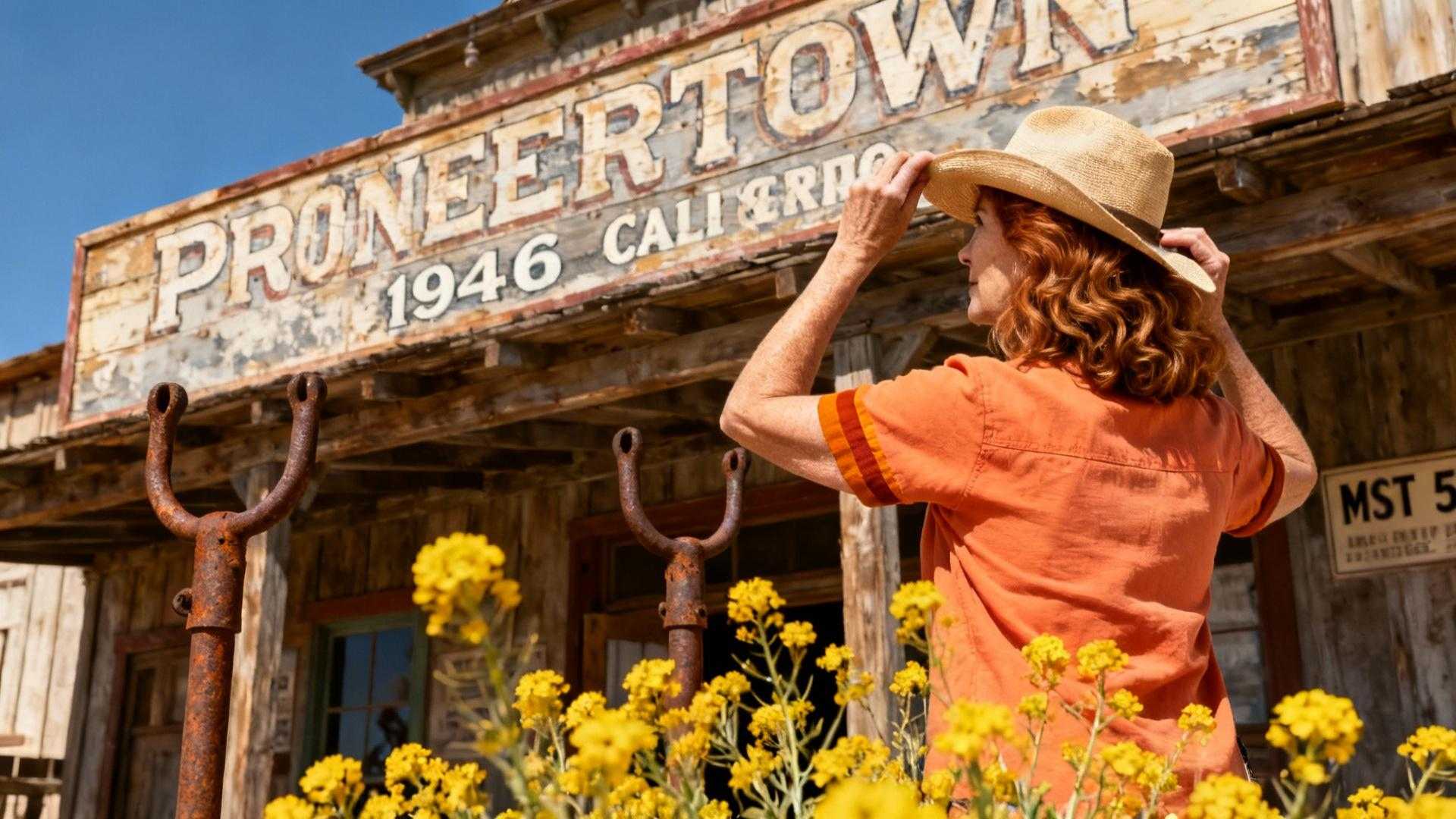I pulled off Highway 62 at dawn, chasing golden light across the Mojave Desert between Yucca Valley and Joshua Tree. What I found ten miles from the national park’s $30 entry gates stopped me cold: weathered wooden storefronts built in 1946 by Roy Rogers and Gene Autry, still standing exactly as they appeared in over 200 Western films. This wasn’t a theme park reconstruction. Pioneertown remains the only functional old-west movie set town in California where residents actually live inside film history, and locals fiercely protect what they call Hollywood’s desert secret.
Most of Joshua Tree’s 3 million annual visitors race past the unmarked turnoff, focused on Instagram rock formations and parking lot chaos. I almost did the same until a hand-painted sign for Pappy & Harriet’s caught my eye. That wrong turn revealed something no guidebook prepared me for: a living town where cowboy stunt shows still happen on streets that hosted Gene Autry’s television series, where artists work in buildings that doubled as 1880s saloons, where the entire community exists as functional cinema architecture.
The authentic movie set architecture that defies Hollywood conventions
How seventeen Hollywood investors built a living film studio in 1946
Dick Curtis conceived Pioneertown as his “Living Breathing Movie Set” when studio backlots couldn’t provide authentic Western atmosphere. He convinced Roy Rogers, Dale Evans, Gene Autry, and fourteen other investors to contribute $500 each, purchasing 32,000 acres of high desert specifically designed for cast and crew to actually live while filming. The groundbreaking ceremony on September 1, 1946 featured the Sons of the Pioneers performing what would become the town’s namesake song.
What makes these facades different from every movie ranch
Walk Mane Street at 7am before tour buses arrive, and you’ll understand the distinction immediately. These aren’t false-front facades hiding modern structures—they’re fully functional buildings with 1880s-themed exteriors housing real businesses. The ice cream parlor serves actual customers. The saloon pours genuine drinks. The motel rents legitimate rooms. Over 50 films and television shows were produced here during the 1940s-50s alone, with full production teams living on-site in what remains privately owned residential property today.
The cultural transformation from Hollywood backlot to artistic sanctuary
How contemporary artists discovered what tourists overlook
Pioneertown’s population of less than 600 residents includes musicians, painters, and craftspeople who migrated here seeking the same creative isolation that attracted Hollywood’s golden age. They work in studios that once housed film production offices, sell handmade goods in buildings that appeared in “The Cisco Kid” and “Annie Oakley,” and perform at Pappy & Harriet’s legendary venue where Gram Parsons and Queens of the Stone Age shaped desert rock mythology.
Why locals quietly protect this desert community’s character
Property owners resist theme park conversion despite tourism pressure, maintaining Pioneertown as a functional residential community where people actually live rather than a museum exhibit. The average household size of 1.90 persons across 6.99 people per square mile creates intimate community dynamics—everyone knows when strangers arrive, and locals appreciate visitors who respect the town’s living nature rather than treating it as an Instagram backdrop.
The exclusive experiences mass tourism destinations cannot replicate
Where live cowboy stunt shows happen on authentic film streets
Weekend stunt demonstrations transform Mane Street into working cinema, with performers recreating the same gunfight choreography that appeared in 1950s Westerns. These aren’t theme park actors—they’re continuation of eight decades of entertainment tradition on streets where Gene Autry rode horses between actual businesses. The shows cost nothing beyond respecting the community hosting them, offering access to functional film history impossible to find elsewhere in California.
How dawn exploration reveals what afternoon crowds obscure
Arrive at 6:30am when golden light hits weathered wood exactly as it did for Hollywood cinematographers. You’ll have Mane Street entirely to yourself, discovering hidden artisan shops, photographing authentic architecture without tour groups, and experiencing the same creative atmosphere that transforms Wonder View Trail into private sunrise theater in Utah’s desert valleys. October’s 80°F temperatures make exploration perfect before summer’s 105°F heat returns.
The practical advantages over famous desert alternatives
What free exploration offers versus Joshua Tree’s $30 entry chaos
While Joshua Tree’s parking lots overflow with vehicles fighting for spaces during March-May peak season, Pioneertown charges zero entrance fees for town exploration. Walk every street, photograph every building, discover every hidden shop without reservation systems or timed entry. The national park’s 3 million annual visitors create the crowds this ten-mile-away alternative eliminates entirely, offering cultural depth Joshua Tree’s geological wonders cannot provide.
How authentic dining costs $15-25 versus Palm Springs’ $200+ resorts
Pappy & Harriet’s serves meals for a fraction of Palm Springs’ resort pricing forty miles south, where $150-400 nightly accommodation rates and $25-50 resort fees drain travel budgets. Pioneertown’s lodging averages $80-120, providing authentic desert experience over commercialized luxury. Like Colorado’s protected Narnia ice volcano, locals quietly share their sanctuary with visitors who demonstrate respect for small-town character.
Frequently asked questions about Pioneertown’s unique status
Is Pioneertown really the only functional movie set town in California?
Yes—it’s the only town specifically built as a live-in movie set where residents actually own property and conduct daily life inside film architecture. Other California movie ranches like Paramount Ranch or Melody Ranch are studio backlots or reconstructions, not residential communities with original 1946 buildings still housing functional businesses.
When are the cowboy stunt shows scheduled?
Weekend demonstrations typically occur Saturdays and Sundays, though schedules vary seasonally. October through April offers the most consistent programming during optimal 80°F desert weather, avoiding summer’s extreme heat when performances pause.
How do I visit respectfully without disrupting the residential community?
Arrive weekday mornings before 10am for intimate exploration, support local artisan shops and Pappy & Harriet’s, photograph respectfully without entering private property, and remember this is people’s actual home—not a theme park designed for tourism.
